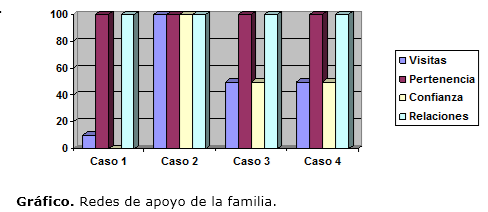Diagnosis on social insertion to the community of families with children requiring special education
Keywords:
Family, Child, Special education, Social adjustment.Abstract
Introduction: in the Psycho-Pedagogical Medical Center of Pinar del Río children requiring special education and their families are attended. Difficulties with the families’ social insertion to the community were confirmed, such as nonsystematic participation, the fact that they do not relate with their neighbors nor maintain support networks.Objective: to identify the social insertion of families with children requiring special education belonging to the Psycho-Pedagogical Medical Center of Pinar del Río, by applying techniques to the family and the community where they live.
Material and method: qualitative and quantitative techniques and methods were used, such as the dialectical-materialistic general method that rules the study, theoretical methods like the historical and logical, the systemic, investigation-participative action, and ethnographic. Empirical methods were also used, such as the interview, the participative observation and the survey. The techniques used are discussion group, semantic differential and family environment inventory.
Results: 100% of the families possess scarce knowledge about the topic of social insertion or its importance. In the 50% of the cases, the families have sense of belonging to their community, while in 100% of the cases community participation is poor, in the case of fathers it is scarce and in the case of the children and their mothers it is null.
Conclusions: the social insertion of families with children requiring especial education denotes to be a topic treated by science, but it should be treated from different approaches to positive influence them.
Downloads
References
1. Ortega Silva P. Torres Velásquez LE, Reyes Luna A, Garrido Garduño A. Cambios en la dinámica familiar con hijos con discapacidad. Revista Psicología Científica[Internet]. 2012[Citado 2014 Jun 15]; 16: [Aprox. 22 p.]. Disponible en: http://www.psicologiacientifica.com/hijos-con-discapacidad-cambios-familia/
2. Guibert Reyes W. Aprender enseñar y vivir es la clave. La Habana: Editorial Científico Técnica; 2006. p. 75.
3. Ruiz Díaz MV. El papel de la familia en la educación del alumnado con necesidades específicas de apoyo educativo. Revista Innovación y experiencias educativas[Internet]. 2010[Citado 2010 octubre 23]; 35: [Aprox. 2 p.] Disponible en: http://www.csi-csif.es/andalucia/modules/mod_ense/revista/pdf/Numero_35/MARIA_VICTORIA_RUIZ_DIAZ_01.pdf
4. Gómez Cardoso AL. Núñez Rodríguez OL. La familia del niño con necesidades educativas especiales de tipo intelectual: ¿Disfunción familiar? Revista Ilustrados[Internet]. 2011[Citado 2011 Abr 15]; [Aprox. 2 p.] Disponible en: http://www.ilustrados.com/tema/9438/familia-nino-necesidades-educativas-especiales-tipo.html
5. Hernández Sampier R. Metodología de la investigación cuantitativa. 2da Edición. Editorial Félix Varela. Cuba, 2006.
6. Rodríguez García G. Metodología de la investigación cualitativa. Editorial Félix Varela. La Habana, 2006.
7. Pincheira Muñoz LE. La importancia de la familia como actor colaborativo y participativo con un hijo/a con discapacidad intelectual desde la actual política de educación especial. Revista Akademeia[Internet]. 2010[Citado 2011 Abr 15]; 5(2): [Aprox. 3 p.] Disponible en: http://www.revistaakademeia.cl/?p=1084
8. Vázquez Vázquez A, Pérez Pacheco KM, Pérez Martín JF, García Fernández I, Victorero Aguilar I. et al. Niños y niñas con necesidades educativas especiales de tipo intelectual. Aproximaciones a la orientación familiar. Revista Avances[Internet]. 2010[Citado 2010 Ene 8]; 12(1): [Aprox. 7 p.] Disponible en: http://www.ciget.pinar.cu/Revista/No.2010-1/Articulos/Necesidades_Educativas_Especiales.pdf
9. Pineda Pérez EJ, Gutiérrez Baró EH, Escalona Mariño S. Impacto de una estrategia de intervención educativa a padres de niños con Síndrome de Down para el desarrollo del autovalidismo. Memorias Convención Internacional de Salud Pública. Cuba Salud 2012[Internet]. La Habana: MINSAP; 2012; [Aprox. 8 p.] Disponible en: http://www.google.com.cu/url?q=http://www.convencionsalud2012.sld.cu/index.php/convencionsalud/2012/paper /viewFile/291/129&sa=U&ei=F_EzVLXQB5G0yATBjID4DA&ved=0CBIQFjAA&usg=AFQjCNHM0w2pYCS16sO9A9mTPEtdiCL9lQ [Citado Dic 3 de 2013]
10. López Sánchez L, López Sánchez GF. Enseñanza del tenis para personas con síndrome Down. Una experiencia práctica. Revista Digital de Educación Física[Internet]. 2013[Citado Dic 3 de 2010]; 20(4): [Aprox. 2 p.] Disponible en: http://dialnet.unirioja.es/descarga/articulo/4197076.pdf
11. García Pérez RP, Morales Femenías Y, García Rodríguez E, Concepción González-Pardo S, Matos Lores M, López Leiva R, et al. Las redes de apoyo social en la vida de las personas con discapacidad. Una introspección a la temática. Revista MEDICIEGO[Internet]. 2013[Citado 2011 Abr 15]; 19(1): [Aprox. 4 p.] Disponible en: http://www.bvs.sld.cu/revistas/mciego/vol19_01_13/pdf/T17.pdf
12. Diéguez Calderón MT, Oramas Domínguez I. Participación Social y Comunitaria en Salud. Revista Ilustrados[Internet]. 2011[Citado 2011 Abr 15]; [Aprox. 5 p.] Disponible en: http://www.ilustrados.com/tema/10602/Comunidad-Participacion-Social-Comunitaria-atencion-primaria.html

Published
How to Cite
Issue
Section
License
Authors who have publications with this journal agree to the following terms: Authors will retain their copyrights and grant the journal the right of first publication of their work, which will be publication of their work, which will be simultaneously subject to the Creative Commons Attribution License (CC-BY-NC 4.0) that allows third parties to share the work as long as its author and first publication in this journal are indicated.
Authors may adopt other non-exclusive license agreements for distribution of the published version of the work (e.g.: deposit it in an institutional telematic archive or publish it in a volume). Likewise, and according to the recommendations of the Medical Sciences Editorial (ECIMED), authors must declare in each article their contribution according to the CRediT taxonomy (contributor roles). This taxonomy includes 14 roles, which can be used to represent the tasks typically performed by contributors in scientific academic production. It should be consulted in monograph) whenever initial publication in this journal is indicated. Authors are allowed and encouraged to disseminate their work through the Internet (e.g., in institutional telematic archives or on their web page) before and during the submission process, which may produce interesting exchanges and increase citations of the published work. (See The effect of open access). https://casrai.org/credit/


